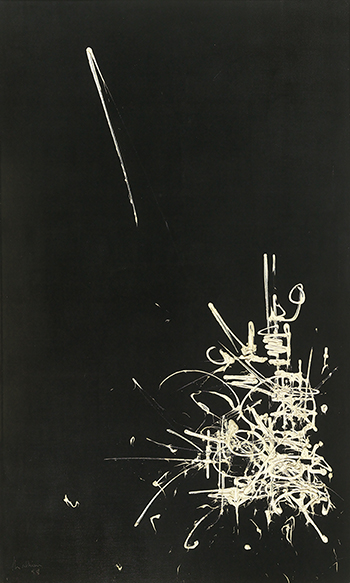PROVENANCE:
Carlo Van Den Bosch, Anvers
Private collection, Belgium
Sotheby’s Paris, Contemporary Art, 2015, lot 110
Acquired by the present owner from the above
EXHIBITED:
Georges Mathieu , Palais des Beaux-Arts, Bruxelles, 1963
Catalogue Note:
CALLIGRAPHER OF THE WEST
As a substantial foundation and a signi f icant institution of contemporary art in Paris, George Pompidou, the founder of the Pompidou Center in Paris, had a close relationship with Georges Mathieu. During Pompidou’s presidency in France (1962-1968), Mathieu was considered as the official representative of culture for France. In 2017, France was celebrating the establishment of Centre Pompidou for its 40th anniversiry since 1977, 40 sites were chosen in the collaboration of this celebration. Among those, domaine national de Chambord has selected more than 80 artworks to be shown from the collection of Pompidou Center and private loans. The sections included five sections: Modern masters; Abstractions; New Realism; Kinetic art, Figurations. One of those exceptional works was “Micromégas” painted in 1973 by Georges Mathieu, on loan from the Pompidou Center at 1.3 meters width. The work titled “Micromégas” was probably inspired by French Enlightenment writer, philosopher Voltaire’s science fiction. Georges Mathieu was an avid reader, with intense study of literature, history, law, and philosophy, which would later become the solid foundation for his inspirations as seen in his works.
In the work of “Traité de paix du Duc de Bourgogne et de la Duchesse de Luxembourg” which is seemingly abstract in compositions, it is entitled with an apparent title. Georges Mathieu added his personal impression to the historical event that took place in the past. According to traces of history, the last Duke of Burgundy was Charles the Bold (Charles le Téméraire), who was born in 1433, he reigned from 1467 to 1477. During his sovereignty, Charles the Bold was ambitious in the expansion of his territories, and attempted to keep the sovereignty of Burgundy as an independent political entity, and freed from French control. In 1467, in order to obtain greater mutual political power between Burgundy and England, Charles the Bold married Marguerite of York, the sister of King Edward IV of England. Until the actual wedding took place in June of 1468, Louis XI, king of France of France did everything in his power to interfere with this political alliance of marriage.
The marriage of Margaret and Charles was seen as the most brilliant marriage of the century, Margaret was also considered as the most powerful Duchess of Europe during that time. Despite that, Louis XI, king of France was already glowering at them, and sought to accelerate his actions to sabotage the power of Duke of Burgundy. Between 1473 and 1475, there was a short period of truce between Louis XI and the Duke of Burgundy. When the truce agreement terminated, king of England, Edward IV was planning an invasion of France. However, King Louis XI offered Edward a huge sum of cash, a yearly annuity for a long truce in return for his withdrawn support for Charles. As a result, Charles was defeated by the King of France, Louis XI and his allies. Charles never gave up on any opportunity to regain his territory, In the last battle he prepared for a siege, yet was again defeated by the Swiss troops and died in 1477.
Between 1957 to 1958, Georges Mathieu had painted three to four paintings in the realm of Duke of Burgundy and Duchess of Luxembourg. They were probably painted for the 1957 exhibition of “Cycle des Grands Ducs d'Occident” held at Galerie Helios Art in Brussels. For someone like Mathieu who has a post-graduate diploma in English philology and English literature, and he would have a much deeper and insightful understanding of the history between England and France. He is known to name his works in accordance to a specific subject matter, often derived from famous battles, classical histories, as a form of paying tribute to the heroes of the past, and declared his patriotism. In this particular work “Traité, du Duc de Bourgogne et de la Duchesse de Luxembourg” was exhibited at the Palais des Beaux-Arts in Brussels in 1963. As an advocate of “Abstract Lyrique” which formed in the late 40s in France, it is the equivalent of “Tachiste” in the European region. Through unleashing rapid storkes and spontaneous brushworks, Mathieu expressed the historic events with striking contradicting colors. In this case, the use of only black and white could be an indication of the marriage contract, and how explosive white marks signifies the traces of history left behind on the black vertical ground. Mathieu believed that the following criteria must be met to be considered as “Abstract Lyrique” works. They’re speed of execution; no pre=meditated movements; no pre-existing forms; and concentration. The artist once said that “A work of art is a fragment of the world which is a world itself. Making art is a revenge on God. The artist creates another world.”
The long-lived artist Georges Mathieu passed away in age of 91, he held over 200 exhibitions and have had his works in major museums around the world. There are over 22 museums in the United States, and over 35 public and private institutions possessed collection of Mathieu. Others included the Tel Aviv Museum of Art, Israel; The National Museum of Modern Art, Tokyo; Kunsthaus Zürich; Didrichsen Art Museum, Finland; National Gallery of Canada, etc.
